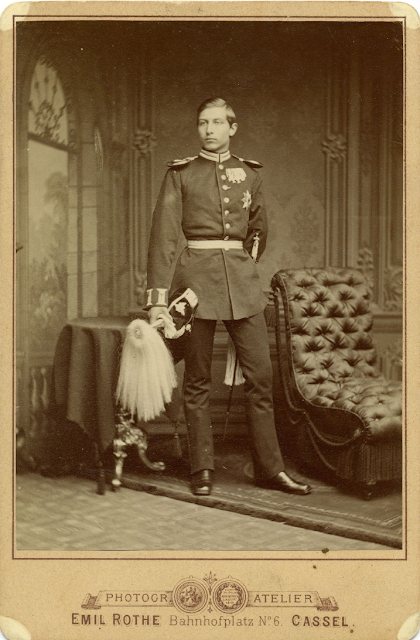This week I will be examining an emperor with a dodgy arm, who had a bad relationship with his mother. Hold on…. have I already done this one? Let me check my notes…. nope. Apparently, this happened to more than one guy.
Kaiser Wilhelm II (1859-1941) was King of Prussia and Emperor of Germany from 1888 to 1918. He was also the last Emperor of Germany, as he led them into The Great War of 1914-1918, which did not end well for them. What impact did his disability have? Let’s find out!
Disability! What Disability?
Wilhelm II was born Friedrich Wilhelm Viktor Albert in Berlin, on 27 January 1859. His mother was Vicky, the eldest daughter of Queen Victoria of the United Kingdom of Great Britain and Ireland. His father was Prince Friedrich Wilhelm (‘Fritz’) of Prussia.
During Wilhelm II’s birth, things went horribly wrong. Firstly, when Vicky went into labour, Fritz sent a letter via regular post to the doctor! Unsurprisingly, by the time the doctor received word of the labour, Vicky was in a bad way. Secondly, as Vicky was a royal, there was strict etiquette regarding access to her body. This meant doctors had to work underneath her skirts. Finally, it was discovered that Wilhelm was in the breach position (essentially facing the wrong way). This endangered the lives of both mother and baby. To remedy this, the doctor used forceps to grab Wilhelm’s left arm, twist him around and yank him out. He was thought to be dead, but was resuscitated and survived. In freeing Wilhelm from his mother, the doctor had severed the nerves in his left arm and neck. This is known as Erb’s palsy and resulted in paralysis of the left arm, as well as a shrivelled arm and hand.
Various ‘Treatments’ Wilhelm Underwent
Before I describe the various ways young Wilhelm was tortured (sorry, ‘treated’) for his disability, I feel some context needs to be given. Prussia was a very militaristic society. As such, men and particularly royalty were expected to be excellent soldiers and generals. A physical impairment does not really help in this regard. To make matters worse, Wilhelm had an English mother. Vicky was very progressive for her time and felt superior to the Prussians, seeing them as antiquated in their views. She knew she could change this as her husband was in line to be king. All she needed was a healthy son to follow him. Obviously, the crippled Wilhelm put an end to these plans.
Vicky wanted to do everything she possibly could to cure Wilhelm of his impairment. She was guided by the best scientific knowledge of the time. When Wilhelm was a few months old, doctors tied his right arm behind his back to force him to use his left. However, the arm was paralysed, so that didn’t work. When Wilhelm was a year old, they tried electromagnetic therapy on his arm. Yep! That’s right! They tried to Frankenstein his arm back to life. They also used a technique called ‘animal baths’. They would wrap a fresh animal carcass (usually that of a hare) around his arm in the hope that the warmth and vigour of the animal would revitalise the arm. This process was repeated on a regular basis for several years, without result.
His arm was not the only problem. The nerves in his neck were also damaged and from the age of four, his head began to twist and drop to one side. Wilhelm was forced to wear a ‘head-stretching machine’ for an hour a day to try to correct this. Vicky described the machine as consisting of
‘a belt around the waist to the back of which an iron bar is fixed. This bar leads up to the back to something which looks exactly like a horse’s bridle. The head is then fixed in this and positioned as desired by means of a screw which adjusts the iron bar’.
The doctors increased the amount of time he was to wear it, as they thought it was beneficial. All I can say is I’m glad I live in the 21st Century.
His Mental State
As you may imagine, Wilhelm was left traumatised by the treatments he underwent as a child. Attempts were made to hide the fact that he had a shrivelled arm. In photographs, he would cover up his hand, or rest it on an item like a sword to disguise the length discrepancy. His clothes were also tailored for this same purpose. He became Emperor of Germany at the age of 29, after his grandfather and father died in quick succession. Being displeased at the way his grandfather, Kaiser Wilhelm I ruled, Wilhelm II wanted a more hands on approach. He therefore dismissed the great statesman, Otto von Bismarck, who had done so much for the German Empire and European stability. Wilhelm II wanted everyone in the world to know who he was. He advocated aggressive foreign policy to grow Germany’s power in the world. It appears he had an inflated view of himself, while also being reckless and irrational in his actions.
Wilhelm II had a desire to outshine Britain. This may have stemmed from the hatred of his mother for the way she treated him. In 1896, he congratulated a Boer commander for successfully defeating the British in battle. Furthermore, he started to build up the German navy to compete with the British navy. This led to an arms race which ultimately resulted in the First World War. I don’t think he thought things through properly. By giving Austria-Hungary support against Serbia after Franz Ferdinand was assassinated in 1914, he set off a chain of events that would lead to catastrophe. The royal families of Germany, Britain and Russia were all interlinked. Now that’s what I call a family feud!
Next week I will look at the American President Franklin Delano Roosevelt.
The Wheelchair Historian
Further Reading
Armfield, Julia, ‘Treating the Kaiser’s Withered Arm’, 28 February 2014 https://blogs.bl.uk/untoldlives/2014/02/treating-the-kaisers-withered-arm.html Accessed: 28 August 2020.
BBC, http://www.bbc.co.uk/history/historic_figures/wilhelm_kaiser_ii.shtml Accessed: 28 August 2020.
Biography.com, ‘Kaiser Wilhelm Biography’ https://www.biography.com/political-figure/kaiser-wilhelm Accessed: 12 August 2020.
Brignell, Victoria, ‘Dangerous disabled people II’ 7 January 2009 https://www.newstatesman.com/blogs/crips-column/2009/01/germany-wilhelm-war-austria Accessed: 28 August 2020.
Mombauer, Professor Annika, ‘Kaiser Wilhelm II: from early years to exile’, Updated Monday, 16th December 2013 https://www.open.edu/openlearn/history-the-arts/history/world-history/kaiser-wilhelm-ii-early-years-exile Accessed: 28 August 2020.
Owen, Jonathan, ‘Kaiser Wilhelm II’s unnatural love for his mother ‘led to a hatred of Britain’’ Saturday 16 November 2013 01:39 https://www.independent.co.uk/news/uk/home-news/kaiser-wilhelm-ii-s-unnatural-love-for-his-mother-led-to-a-hatred-of-britain-8943556.html Accessed: 28 August 2020.
Röhl, John C. G., ‘Kaiser Wilhelm II: A Concise Life’, (Cambridge University Press, 21 Aug 2014).
Starr Brown, Rebecca, ‘Kaiser Wilhelm II’s Britishness (And Left Arm)’, January 27, 2017 https://rebeccastarrbrown.com/2017/01/27/january-27-kaiser-wilhelm-ii-is-born/ Accessed: 28 August 2020.



